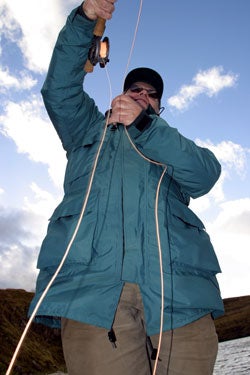| WET FLIES A few weeks ago I read an article in one of the fishing journals about fishing wet flies. What caught my attention was that it appears that wet fly fishing is little practiced nowadays by all but a few middle-aged and elderly angling eccentrics. I am sure that this is not true or maybe I’m out of touch. I remember that when I first really got into trout fishing on Hayfield Anglers and Prince Albert waters in the sixties (I missed the Beatles and all that!) most trout fishing was with wet flies early in the season and, as the weather improved, dry fly fishing came into its own. I was also getting into nymph fishing as an alternative but not really appreciating it. Ever since I have maintained a cross section of wet flies and used them quite a lot, too. Just such an opportunity came along last Thursday when fishing Laneshaw Reservoir above Colne in east Lancashire. It was a warm, very cloudy day and, when I arrived at 7.30 am there was a very strong westerly wind blowing the water up into quite large waves in unsheltered parts. I walked around the water and found that the effects of the wind were least severe on the bank opposite the fishing hut, along the moor side arm towards the feeder stream. The breeze was coming in directly from left to right and it would make casting much more comfortable than the other bank. (This again provided an example, for three other anglers appeared during the morning, tried a few casts into the fierce wind from the car park side and then decamped. A walk of half a mile would have brought them into calmer waters!).
There were fish swirling around in the top layers of the water and occasionally breaking through. I had to fish on top of the water and, with the recent ‘read’ in mind I reached for my box of wet flies. I had a nine foot Fulling Mill rod with a WF5 floating line to which I attached eight feet of eight pound line down to a small Drennan ring, the next four feet of line were six pound fluorocarbon to another ring and the tippet was a further four feet of four pound fluorocarbon. I’m a recent convert to these rings and I find that, whilst not being approved of by the purists, they are a great help to an older angler whose eyes are failing and whose fingers are losing coordination. I’ve been using them for a year and I have caught fish up to double figures and not experienced any problems with them. I tied a bushy Kate McLaren on the top dropper as an attractor fly that would cause a wake if on the surface and some turbulence if it sank. The middle fly was a Peter Ross, a fly pattern I picked up in Sutherland last year and dressed in a very striking orangey red. On the point I tied a Black Pennel, all in size 14 hooks. Fishing the flies I fished from a little peninsula, a result of falling water levels and, because of the wind, I was able to cover a ninety degree arc, casting out directly in front, then gradually round to my right and in to the bank. Most casts were quite short and the retrieve started just a couple of seconds after the leader landed on the water, enough time to cut into the surface film and begin to sink. I was busy from the first cast and seemed to have a pluck or a take each time. I netted eight fish in just over an hour – all rainbows up to three pounds and, my word, were they fighters! I had everything from high leaps, walking on water and deep submarine surges out towards the centre of the reservoir in attempts to shake themselves loose. The takes were very positive and, in most cases I could see the fish homing in for the last few feet before the take as they hunted down the fly. I lost four others off the hook and in quite a few more cases I managed to pull the fly out of the trout’s mouths before the hook set. I realised that I was pulling my flies up against the wind and that the fish were following. A short delay before tightening put an end to that problem but, even after forty-odd years the sight of a big trout bearing down on the fly requires even greater control and patience from the angler to hook the fish; I was getting too excited! Best fly I did not change flies at all during the session. I persevered with the same line and leader casting in an arc of ninety degrees, first of all short, then longer. Fish came from all parts of the arc including two that were hard in by the stones that formed the banking to my right. There was no need for long casting and the retrieve was from slow to jerky fast and slow again to the final lift out of the water. The most successful fly was the Black Pennell, five fish, and the least successful, one fish, was the Peter Ross. A truly stimulating and very active session, perhaps the very best of the summer so far. Tight Lines Eddie Caldwell |
Welcome!Log into your account














